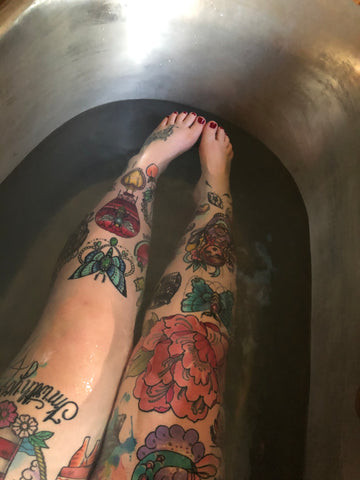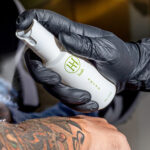Navigating the world of tattoo aftercare can be tricky, especially when it comes to water exposure. At tattooat.com, we understand the importance of proper tattoo healing, so we’ve created a comprehensive guide answering the question: “Can You Submerge A Tattoo In Water?” We’ll explore the do’s and don’ts of tattoo aftercare, ensuring your body art remains vibrant and infection-free, plus, find the ideal artist and artwork for you with our resources.
1. What Happens If You Submerge a New Tattoo in Water?
Submerging a new tattoo in water, particularly for extended periods, poses risks during the crucial initial healing phase. A freshly inked tattoo is essentially an open wound, making it vulnerable to bacteria and potential infection. Water, especially from sources like bathtubs, swimming pools, or hot tubs, can harbor microorganisms that can compromise the healing process. Keeping your new tattoo dry is key to preventing complications, so avoid prolonged soaking.
Here’s what can happen if you submerge a new tattoo in water:
- Increased Risk of Infection: Water can introduce bacteria into the open wound, leading to infections.
- Ink Leaching: Submerging can cause the tattoo ink to leach out, resulting in a faded or patchy appearance.
- Delayed Healing: Excessive moisture can hinder the formation of a protective scab, prolonging the healing process.
- Skin Irritation: Chemicals in the water, such as chlorine in pools, can irritate the sensitive skin around the tattoo.
To avoid these issues, it’s best to stick to quick showers and follow your tattoo artist’s specific aftercare instructions, explore tattooat.com for verified artist and aftercare tips.
2. How Long Should You Wait Before Submerging a New Tattoo?
The general recommendation is to wait at least 2 to 4 weeks before submerging a new tattoo in water, but it’s essential to consider individual healing rates and the tattoo artist’s advice. The initial 2 to 4 weeks are critical because the skin is still actively repairing itself. Premature submersion can disrupt this process and increase the risk of complications.
Here’s a general timeline:
- First Week: Avoid any submersion. Stick to quick showers and gently clean the tattoo with mild, fragrance-free soap.
- Weeks 2-4: Continue showering and avoid prolonged soaking. If you must submerge, use a waterproof bandage or barrier, but ensure it doesn’t stay on for too long after.
- After 4 Weeks: Once the tattoo is fully healed, submersion is generally safe, but continue to moisturize and care for the skin.
Factors influencing the waiting period:
- Tattoo Size and Location: Larger tattoos or those in areas prone to friction may take longer to heal.
- Individual Healing Rate: Some people heal faster than others due to factors like age, health, and lifestyle.
- Aftercare Practices: Proper cleaning and moisturizing can speed up the healing process.
Always consult your tattoo artist for personalized advice tailored to your specific tattoo and skin type. Find a qualified artist on tattooat.com.
3. Showers vs. Baths: Which is Safer for a New Tattoo?
Showers are generally safer than baths for new tattoos because they minimize the risk of prolonged water submersion. When you take a bath, the tattoo is immersed in water that may contain bacteria and chemicals, increasing the risk of infection and irritation. Showers, on the other hand, allow you to clean the tattoo without prolonged exposure to standing water.
Here’s why showers are preferred:
- Reduced Submersion: Showers allow you to control the amount of water that comes into contact with the tattoo.
- Cleaner Water: Shower water is typically cleaner than bathwater, reducing the risk of introducing bacteria.
- Easy Cleaning: Showers make it easier to gently clean the tattoo with mild soap and rinse thoroughly.
Tips for showering with a new tattoo:
- Use Lukewarm Water: Hot water can cause the tattoo to swell and leach ink.
- Avoid Direct Pressure: Don’t aim the shower stream directly at the tattoo.
- Use Mild Soap: Choose a fragrance-free, antibacterial soap to clean the tattoo gently.
- Pat Dry: After showering, gently pat the tattoo dry with a clean towel instead of rubbing.
If you must take a bath, consider protecting the tattoo with a waterproof bandage and limiting the duration of the bath. However, showers remain the safer option during the initial healing period.
4. What Type of Water is Safest for a New Tattoo?
The type of water that comes into contact with a new tattoo can significantly impact its healing process. Contaminated or chemically treated water can introduce harmful substances and bacteria, leading to infections and complications.
Here’s a breakdown of different types of water and their safety levels:
- Tap Water: Generally safe for showering and cleaning, but it can contain chlorine and other chemicals that may cause irritation.
- Bottled Water: A safer option for cleaning, as it is typically free from contaminants and chemicals.
- Distilled Water: The purest form of water, ideal for cleaning a new tattoo due to its lack of minerals and contaminants.
- Swimming Pools: High in chlorine and bacteria, making them unsafe for new tattoos until fully healed.
- Oceans and Lakes: Natural bodies of water can contain various microorganisms and pollutants that can cause infections.
- Hot Tubs: Warm water and high bacteria levels make hot tubs particularly risky for new tattoos.
When cleaning your new tattoo, using bottled or distilled water is preferable to tap water. Avoid swimming pools, oceans, lakes, and hot tubs until the tattoo is fully healed to minimize the risk of infection. If you’re unsure about the water quality in your area, consult your tattoo artist or a healthcare professional.
5. Can You Go Swimming with a New Tattoo?
Swimming with a new tattoo is highly discouraged due to the risk of infection and damage to the healing process. Both chlorinated pools and natural bodies of water contain bacteria and chemicals that can compromise the tattoo’s integrity.
Here’s why swimming is risky:
- Chlorine: Pool chlorine can irritate the skin and leach ink from the tattoo, causing fading and discoloration.
- Bacteria: Pools, oceans, and lakes harbor bacteria that can enter the open wound and cause infections.
- Prolonged Submersion: Swimming involves prolonged submersion, increasing the risk of waterlogging and delayed healing.
If you must swim, consider these precautions:
- Waterproof Bandage: Apply a waterproof bandage or sealant to protect the tattoo, but be aware that these are not foolproof.
- Limit Duration: Keep your swim as short as possible to minimize water exposure.
- Clean Immediately: After swimming, remove the bandage and clean the tattoo with mild soap and water.
- Monitor for Signs of Infection: Watch for redness, swelling, pain, or discharge, and seek medical attention if necessary.
However, the best approach is to avoid swimming altogether until the tattoo is fully healed. Consider alternative activities that don’t involve water submersion to protect your new body art. Tattooat.com has a list of professional artists who understand aftercare for safe tattoo experiences.
6. How to Properly Clean a Tattoo After Accidental Water Exposure
Accidents happen, and sometimes a new tattoo may unintentionally get wet. If this occurs, it’s essential to take immediate steps to minimize potential damage and prevent infection.
Here’s how to properly clean a tattoo after accidental water exposure:
- Remove Excess Water: Gently pat the tattoo dry with a clean, soft towel. Avoid rubbing, as this can irritate the skin and disrupt the healing process.
- Wash with Mild Soap: Use a fragrance-free, antibacterial soap to gently cleanse the tattoo. Lather the soap in your hands and carefully wash the area, removing any dirt or debris.
- Rinse Thoroughly: Rinse the tattoo with lukewarm water to remove all traces of soap. Ensure no soap residue remains, as this can cause irritation.
- Pat Dry Again: Gently pat the tattoo dry with a fresh, clean towel.
- Apply Aftercare Ointment: Apply a thin layer of aftercare ointment, such as Aquaphor or a tattoo-specific balm, to keep the skin moisturized and promote healing.
- Monitor for Signs of Infection: Keep a close eye on the tattoo for any signs of infection, such as redness, swelling, pain, or discharge. If you notice any of these symptoms, consult a healthcare professional immediately.
In addition to these steps, it’s crucial to avoid further water exposure until the tattoo is fully healed. Stick to quick showers and avoid swimming, baths, and hot tubs.
7. What Are the Signs of a Tattoo Infection?
Recognizing the signs of a tattoo infection is crucial for prompt treatment and preventing potential complications. Infections can occur if bacteria enter the open wound during the healing process, leading to a range of symptoms.
Here are the common signs of a tattoo infection:
- Redness: Increased redness around the tattoo area, especially if it spreads beyond the initial outline.
- Swelling: Significant swelling and inflammation around the tattoo.
- Pain: Increased pain or tenderness that is not relieved by over-the-counter pain medication.
- Discharge: Pus or fluid oozing from the tattoo, which may be yellow, green, or bloody.
- Fever: A high fever accompanied by chills and body aches.
- Warmth: The skin around the tattoo feels unusually warm to the touch.
- Foul Odor: An unpleasant odor emanating from the tattoo area.
- Blisters or Sores: Formation of blisters, sores, or raised bumps around the tattoo.
If you experience any of these symptoms, it’s essential to seek medical attention immediately. A healthcare professional can diagnose the infection and prescribe appropriate treatment, such as antibiotics or topical creams.
Ignoring a tattoo infection can lead to more severe complications, such as scarring, permanent skin damage, or systemic infections. Early detection and treatment are key to ensuring a successful healing process. Tattooat.com offers advice articles on tattoo safety and practices for informed decisions.
8. Choosing the Right Tattoo Aftercare Products
Selecting the right aftercare products is essential for promoting proper healing and preventing infections. Not all products are created equal, and using the wrong ones can hinder the healing process or cause adverse reactions.
Here’s a guide to choosing the right tattoo aftercare products:
- Cleansers: Opt for fragrance-free, antibacterial soaps or cleansers specifically designed for tattoos. Avoid harsh soaps that can dry out the skin and disrupt the healing process.
- Ointments: Choose a healing ointment, such as Aquaphor or a tattoo-specific balm, to keep the skin moisturized and promote cell regeneration. Avoid petroleum-based products, which can clog pores and trap bacteria.
- Moisturizers: After the initial healing phase, switch to a fragrance-free, hypoallergenic moisturizer to keep the skin hydrated and prevent dryness.
- Sunscreen: Once the tattoo is fully healed, protect it from sun exposure by applying a broad-spectrum sunscreen with an SPF of 30 or higher. Sunscreen can prevent fading and damage to the tattoo.
Ingredients to avoid in aftercare products:
- Fragrances: Can cause allergic reactions and skin irritation.
- Alcohol: Can dry out the skin and delay healing.
- Petroleum: Can clog pores and trap bacteria.
- Dyes: Can cause allergic reactions and skin irritation.
When in doubt, consult your tattoo artist for recommendations on the best aftercare products for your skin type and tattoo. They can provide personalized advice based on their experience and knowledge.
9. Can You Use Saniderm or Second Skin to Protect a New Tattoo from Water?
Saniderm and Second Skin are popular adhesive bandages used to protect new tattoos during the initial healing phase. These bandages are waterproof and breathable, creating a barrier against bacteria and contaminants.
Here’s how Saniderm and Second Skin can protect a new tattoo from water:
- Waterproof Barrier: These bandages create a waterproof seal around the tattoo, preventing water from coming into contact with the open wound.
- Reduced Friction: They protect the tattoo from friction and irritation caused by clothing and other external factors.
- Breathability: Despite being waterproof, these bandages are breathable, allowing oxygen to reach the tattoo and promote healing.
- Reduced Scabbing: By keeping the tattoo moisturized, Saniderm and Second Skin can reduce scabbing and promote smoother healing.
However, it’s essential to use these bandages correctly to avoid potential complications. Here are some tips for using Saniderm and Second Skin:
- Apply Properly: Ensure the bandage is applied smoothly and without wrinkles or air bubbles.
- Leave On for Recommended Time: Follow your tattoo artist’s instructions on how long to leave the bandage on. Typically, it’s recommended to leave it on for 3-5 days.
- Remove Carefully: Remove the bandage gently, peeling it back slowly and carefully.
- Clean and Moisturize: After removing the bandage, clean the tattoo with mild soap and water, and apply a thin layer of aftercare ointment.
While Saniderm and Second Skin can provide excellent protection against water, they are not foolproof. It’s still essential to avoid prolonged submersion and follow proper aftercare practices.
10. Long-Term Tattoo Care and Water Exposure
Even after a tattoo is fully healed, proper long-term care is essential to maintain its vibrancy and prevent fading. Water exposure, while no longer a primary concern, can still impact the tattoo’s appearance over time.
Here are some tips for long-term tattoo care and water exposure:
- Moisturize Regularly: Keep the skin hydrated by moisturizing regularly, especially after showering or swimming.
- Protect from Sun Exposure: Apply sunscreen with an SPF of 30 or higher whenever the tattoo is exposed to the sun.
- Avoid Harsh Chemicals: Limit exposure to harsh chemicals, such as chlorine and saltwater, which can fade the tattoo over time.
- Stay Hydrated: Drink plenty of water to keep the skin hydrated from the inside out.
- Maintain a Healthy Lifestyle: A healthy diet and lifestyle can promote healthy skin and prolong the life of your tattoo.
If you notice any significant fading or discoloration, consider getting a touch-up from your tattoo artist. Touch-ups can restore the tattoo’s vibrancy and ensure it looks its best for years to come.
Address: 1825 SW Broadway, Portland, OR 97201, United States
Phone: +1 (503) 725-3000
Website: tattooat.com
Ready to explore the world of tattoos? Visit tattooat.com today for inspiration, artist connections, and expert advice.
 Writer Rosalie Hurr's tattooed legs in the bath.
Writer Rosalie Hurr's tattooed legs in the bath.
FAQ: Submerging Tattoos in Water
1. Can I take a bath the day after getting a tattoo?
No, it’s best to avoid taking a bath the day after getting a tattoo. Fresh tattoos are open wounds susceptible to infection; submerging them in water, which can harbor bacteria, significantly increases this risk. Stick to quick showers and follow your tattoo artist’s aftercare instructions.
2. What happens if my new tattoo gets wet in the shower?
If your new tattoo gets wet in the shower, don’t panic. Gently pat it dry with a clean, soft towel, and avoid rubbing. Ensure you’re using a mild, fragrance-free soap, and apply a thin layer of aftercare ointment to keep it moisturized. Continue to monitor for any signs of infection.
3. How long after getting a tattoo can I swim in a pool?
It’s generally recommended to wait at least 2 to 4 weeks after getting a tattoo before swimming in a pool. Both the chlorine and bacteria found in pools can harm the healing tattoo, leading to irritation and potential infection. Ensure the tattoo is fully healed before exposing it to pool water.
4. Is saltwater bad for new tattoos?
Yes, saltwater can be detrimental to new tattoos. The high salt content can dry out the skin, hindering the healing process. Additionally, oceans can contain various microorganisms that may cause infections. Avoid exposing your new tattoo to saltwater until it’s fully healed.
5. Can I use a waterproof bandage to protect my tattoo while swimming?
While waterproof bandages can offer some protection, they are not foolproof. Water can still seep in, and prolonged use can trap moisture, increasing the risk of infection. It’s better to avoid swimming altogether until your tattoo is fully healed; consult your tattoo artist on specific protection methods if swimming is unavoidable.
6. What are the early signs of a tattoo infection?
Early signs of a tattoo infection include increased redness, swelling, pain, and warmth around the tattoo area. You might also notice a discharge of pus or fluid. If you experience any of these symptoms, seek medical attention promptly to prevent complications.
7. Can I use Vaseline on my new tattoo?
While Vaseline was once a common recommendation, it’s generally not advised for new tattoos anymore. Vaseline is a petroleum-based product that can trap moisture and prevent the skin from breathing. This can increase the risk of infection. Opt for a tattoo-specific aftercare ointment or balm instead.
8. How often should I clean my new tattoo?
You should clean your new tattoo 2 to 3 times a day. Use a mild, fragrance-free soap and lukewarm water. Gently wash the area, removing any dirt or debris, and pat it dry with a clean towel. Follow up with a thin layer of aftercare ointment to keep the skin moisturized.
9. Can I exercise after getting a tattoo?
It’s best to avoid strenuous exercise for the first few days after getting a tattoo. Sweat can irritate the tattoo and increase the risk of infection. Additionally, friction from clothing and equipment can disrupt the healing process. If you must exercise, ensure the tattoo is covered with loose-fitting clothing and cleaned immediately afterward.
10. What should I do if my tattoo is itchy?
Itching is a common symptom during the tattoo healing process. However, it’s crucial to avoid scratching the tattoo, as this can damage the skin and increase the risk of infection. Instead, gently pat or tap the area to relieve the itch. Keeping the tattoo moisturized can also help alleviate itching. If the itching is severe or accompanied by other symptoms, consult your tattoo artist or a healthcare professional.

